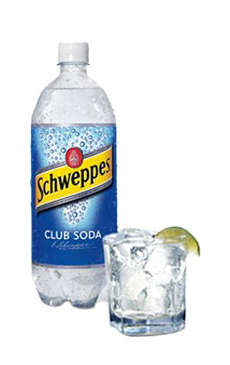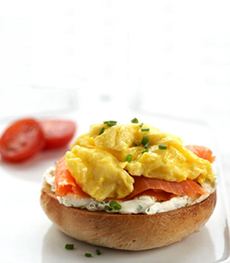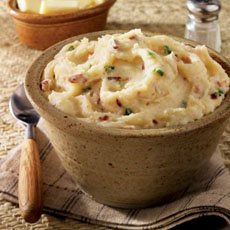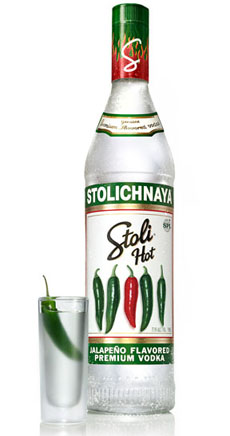|
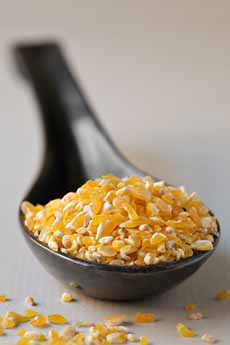
[1] Yellow grits from Anson Mills—the best grits we’ve ever had (photos #1, #2 and #4 © Anson Mills).

[2] White grits are milder-tasting. The yellow variety has a stronger taste and a gentle hint of sweetness.
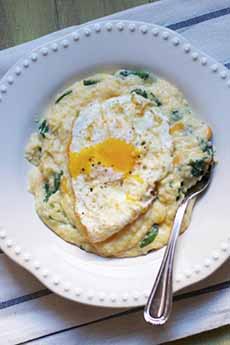
[3] Cheese grits (also called cheesy grits) with spinach and a fried egg. Here’s the recipe from The Baker Chick. Some people add sliced steak as well (photo © The Baker Chick).

[4] Polenta is the Italian word for cornmeal. This is heirloom polenta from Anson Mills.

[5] Braised chicken thighs atop polenta. Here’s the recipe (photo © Good Eggs).
|
|
Three-quarters of grits purchased in the U.S. are sold in the South; the area stretching from Virginia to Texas is sometimes referred to as the “grits belt.” This tip is for everyone who lives outside of it.
But before we dig in, we’ve got to plug the finest grits money can buy, from AnsonMills.com, producer of heritage, organic grits and other fine grains. Your friends who cook will appreciate a bag. There are delicious recipes on the website, too.
If you like cooked cereal or polenta, add grits to your lineup. And enjoy them at all three meals.
Breakfast: as a porridge with with fruit plus a pat of butter, some milk and a sweetener; or as a savory side with eggs. You can stir in cheese to make cheese grits or sprinkle grated Parmesan on them (cheese grits recipe). We like to add a bit of thyme or oregano.
Lunch/dinner: as a side dish with with grated cheese, gravy, sliced green onions, sautéed mushrooms or the creative toppings/mix-ins of your choice (we like a small dice of sautéed bell pepper, mushrooms and onions). Shrimp and grits are a popular pairing.
More ways to flavor grits:
With heat: add minced jalapeños or chipotle, or a mix of cayenne pepper, chili powder, cumin and paprika; serve with salsa.
Garlic grits: Add crushed roasted garlic or garlic powder to plain or cheese grits.
Bacon or sausage grits: mix grits with crumbled bacon or sausage.
Grits can be set like polenta, by placing the cooked grits in an ungreased loaf pan and cooling for 30 minutes or longer. The loaf is turned out and sliced for grilling or frying with a coating of flour, salt and pepper.
The difference between grits and polenta is below.
Grits casserole is another alternative: Combine grits with any ingredients (bell pepper, onions, mushrooms, other vegetables, sausage or other meat including crumbled leftover burgers and seasonings) and bake at 350°F for 35 minutes.
GRITS PURCHASING TIPS
Stone ground: Look for stone-ground grits, which retain the hull and nutritious germ (which houses the wheat germ oil) of the kernel attached. “Degerminated” cornmeal means that the hull and germ have been removed. “Speckled” grits are whole kernel grits.
Slow-Cooking: Although it saves time to prepare instant or quick-cooking grits, they have less corn flavor than the conventional slow-cooking product. Some of the flavor is lost in the par-cooking that speeds up the time on your stovetop.
Color: Grits are yellow or white, based on the color of corn. Anson Mills, producers of heritage grits (and our favorite grits), notes that grits made from white corn have more interesting mineral and floral notes. White corn was historically popular in the urban port cities of the South, while yellow corn was popular inland, in rural areas.
GRITS & POLENTA: THE DIFFERENCE
There is no labeling standard in the U.S., so the answer to the question isn’t readily apparent. Both grits and polenta are ground cornmeal, which is ground from dried maize (maize is another word for corn). The difference is in the grind: Cornmeal for polenta is ground much finer than the pellets of grits, and even cornmeal has varying textures, from coarsely ground to finely ground (also called corn flour). If you want to substitute grits for cornmeal, you can grind them to a finer texture.
We like to think of polenta as “Italian grits” and grits as “America polenta,” but, based on local cuisines, the are served in slightly different ways. Polenta is not served as a breakfast cereal, for example.
And, the types of corn used in the two countries differ. Most American grits are ground from dent corn; most Italian polenta is made from flint corn, which holds its texture better. Thus, American grits can cook up soft, like cream of wheat, while polenta can cook up more toothsome.
WHAT ARE GRITS?
Grits are corn kernels that are soaked in lye or other alkaline solution to remove the casing. At this point, they are known as hominy; hence the term, hominy grits. The hominy is left to harden and then is ground to the texture of tiny pellets, the “grits.”
Grits are boiled with water into a porridge similar to cream of wheat. Grits are of Native American origin, but our modern word comes from the Old English “grytt,” meaning coarse meal.
WHAT IS POLENTA?
Polenta is coarsely-ground yellow corn, also known as cornmeal, that is slowly cooked with milk/cream, stock or water. A staple in Northern Italy, it is called cornmeal mush in the U.S. It can be served soft like grits with a sauce (mushroom ragu is our favorite) or grated cheese; or can be set into a block shape, then sliced and grilled or pan fried. Polenta can be enjoyed plain, with a sauce (tomato sauce is traditional), or topped with fish, meat, pasta sauce or vegetables. As with grits, polenta can be served sweet or savory.
HOW ABOUT MASA?
To add a third variable, there is masa, also called hominy: maize kernels that are dried and treated with a solution of calcium hydroxide, an alkaline solution also called slaked lime and wood ash. This process, which loosens the hulls so they can more easily be separated from the kernels,* is called nixtamalization. Died and ground, the kernels are called masa harina, which is used to make arepas, tamales, tortillas, among other Latin American dishes including a chocolate pudding. It is also the base of corn chips, which were originally made (in Los Angeles), by cutting and frying leftover tortillas.
________________
*In addition, the process softens the corn. As a side benefit, the alkaline solution reacts with the corn so that the nutrient niacin can be more easily assimilated by the digestive tract.
|
